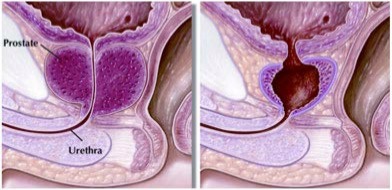Prostate (BPH)
What is the prostate gland?
The prostate is a walnut sized gland that sits underneath the bladder in men. The urethra is a urinary tube that starts from the tip of the penis, passes through the prostate gland, and ends in the bladder. The prostate completely surrounds the urethra.
The prostatic urethra allows urine to empty from the bladder, as well as assisting with the passage of semen during ejaculation.
What is an enlarged prostate gland?
As men age, the inner part of the prostate can enlarge. This results in blockage to the flow of urine as it squeezes the urethra restricting its passage. The name given to an enlarged prostate gland is Benign Prostatic Hypertrophy or BPH.
Nobody is sure why the prostate enlarges but it begins with the male ageing process and usually starts in men in their early 50s.
What symptoms can it cause?
An enlarged prostate gland causes:
- Poor flow
- Intermittent flow
- Straining to empty
- Feelings of incomplete emptying
- Increased frequency
- Urgency
- Getting up at night to urinate
Which men benefit the most from undergoing surgery for an enlarged prostate gland?
- Kidney failure due to an enlarged prostate
- Unable to urinate and requiring a catheter
- Recurrent urinary tract infections
- Recurrent bleeding in the urine caused by prostate enlargement
- Forming bladder stones
- Bothersome symptoms not responding to medications designed to relax the prostate
What is a Holmium Laser Enucleation Prostatectomy (HoLEP)?
A HoLEP is a procedure that enables the surgeon to remove the inside portion of the prostate gland that is restricting the flow of urine. The operation is performed via the urethra with no cuts in the skin.

The procedure is carried out either under a general or spinal anaesthetic. Your anaesthetist will recommend the best option for you.
A small camera called a cystoscope is inserted down the urethra towards the area that is being narrowed by the prostate. A laser fibre is deployed through the cystoscope allowing the safe removal of the inner part of the prostate and the attached urethra. The remaining prostate that is left behind forms an outer shell. The tissue that has been cut away is removed and sent to the lab for examination under a microscope. A urethral catheter is inserted into the bladder at the end of the operation. The catheter has a channel which allows fluid to continuously run through and wash out any blood clots that form in the first 12 hours post-operatively.
What are the benefits?
The surgery should improve your flow of urine, relieve any lower urinary tract symptoms due to prostate enlargement, and reduce any strain placed on your bladder or kidneys from back pressure.
What are the risks?
As with any surgical procedure there are small risks involved.
The general risks include:
- Undergoing a general or spinal anaesthetic- in Australia, it is considered safe with few risks due to the extensive training undertaken. Your anesthetist will discuss these issues in more detail before your surgery.
- Formation of blood clots in the legs or lungs
- Heart, lung or kidney issues
The specific risk of HoLEP include:
- Bleeding – This is uncommon using laser energy, but can occur when a scab falls off the prostate as part of normal healing, usually in the first 2 weeks after surgery. Less than 1 in 100 patients will require a blood transfusion
- Infection can occur in up to 2 in 100 patients
- You may be unable to urinate immediately after the catheter is removed – if this is the case, you will require another catheter to be reinserted in order to go home. You will return to the office one week later for another trial of catheter removal
- Retrograde ejaculation (“dry orgasm”) will occur in up to 8 out of 10 patients. The neck of the bladder does not shut properly during ejaculation and the semen is directed into the bladder instead of out through the penis. You will then pass the semen out during the next urination. This should not affect your ability to achieve an orgasm.
- Erectile dysfunction – the surgery does not damage the nerves that control erections. However, it has been noted that in men with no erection difficulties before the surgery, it may occur somewhere between 5 to 10 patients in every 100 afterwards.
- Stress urinary incontinence is uncommon- occurring in 1 in 200 men, and is due to sphincter weakness. It results in involuntary loss of urine on coughing, sneezing or during sudden physical activity.
- Needing repeat surgery- prostate or scar tissue can regrow into the channel as the operation does not cure BPH. Of 100 patients, 5 will need repeat surgery within 8 years.
What are the alternatives?
A HoLEP is not an essential procedure for most men. Medications designed to relax or shrink the prostate are often first line therapy, and usually have already been commenced already. However, these medications are rarely a permanent long-term solution and often have their own side effects.
There are also other techniques available designed to achieve similar outcomes as HoLEP. They treat the prostate using different energy forms such as electrocautery or Greenlight laser. Each technique has their various good and bad points. Your surgeon can discuss these issues with you in more detail in relation to your particular situation.
What to expect immediately following the surgery whilst in hospital?
The catheter will cause some irritation of the bladder and mild discomfort in the tip of the penis. You will spend one or two nights in hospital, with the catheter being removed in the morning of your anticipated discharge day.
What will my out of hospital recovery be like?
You can expect to have blood in the urine and or pass small clots for the first couple of weeks after your HoLEP. This is an expected outcome and will settle in time.
It may take several months for you to notice improvement in your symptoms and urine flow. You should judge the success of your operation at approximately 3 months.
We advise you to avoid strenuous activities following surgery for the first 4 weeks and gradually build up. Avoid constipation as straining on the toilet may result in prostate bleeding. Laxatives may be required during this period to keep your bowel motions soft. You can usually resume work after 4 weeks following surgery providing you do not perform any strenuous tasks. At 6 weeks you should be able to resume full activities including sexual activity.
It is also important to notify your doctor or attend the Emergency Department if:
- The bleeding is getting heavier, not lighter
- You develop a fever
- You have problems passing urine or worsening pain
- Click here to download Holmium Laser Enucleation Prostatectomy info sheet
You will need the Adobe Reader to view and print these documents.![]()





 Menu
Menu


